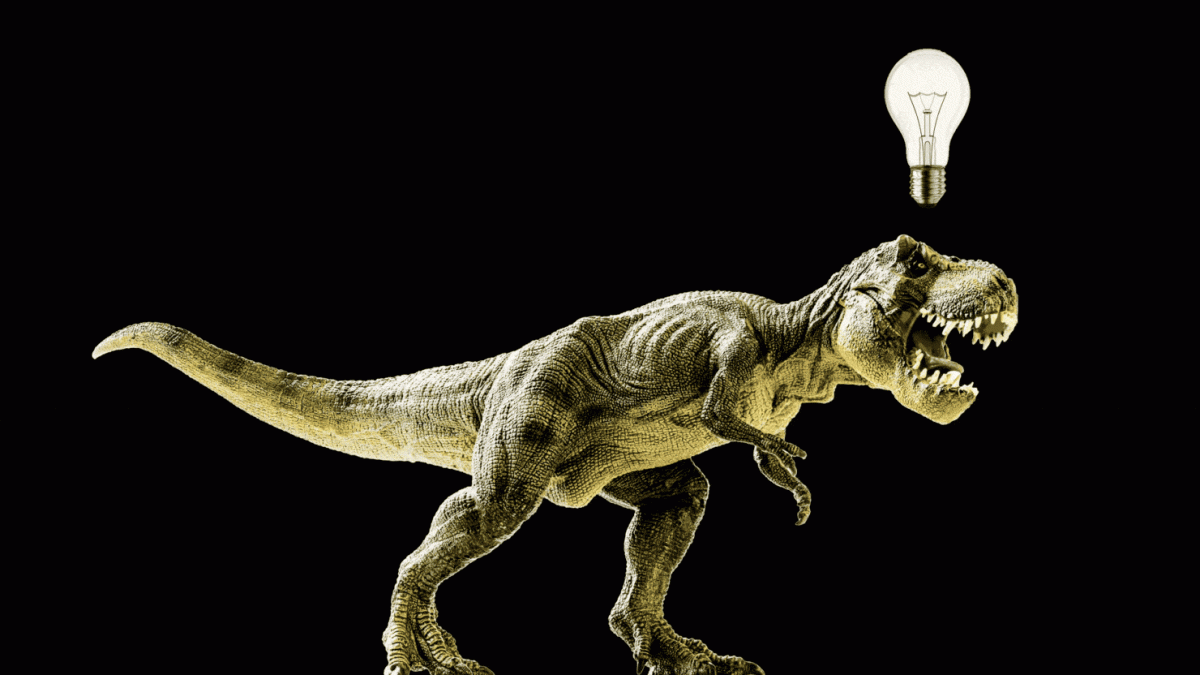New Research Shows That T-Rex Was as Smart as a Chimp

Tyrannosaurus rex was smarter than we thought.
The Tyrannosaurus rex is, without a doubt, the greatest predator to have walked this Earth. As an adult it was an efficient killing machine, with eyes as big as grapefruits and teeth the size of railway spikes that could crush clean through the bones of its prey.
The T. rex has an enormous reputation, but it’s never been known for its intelligence. The standard line for most of paleontological history has been that dinosaurs were unevolved, and frankly, rather dumb.
But in the book The Rise and Fall of the Dinosaurs: A New History of a Lost World, University of Edinburgh paleontologist Steve Brusatte suggests that T. rex was much more than a giant brute—it was social, and likely very smart, as smart as humans’ closest genetic cousins, chimpanzees.
“It does sound like a pretty bold statement, because chimps are quite intelligent, and we’re used to thinking about dinosaurs as being stupid,” he told The Daily Beast. “That’s the way I was taught about them in school—that they were these walnut-brained losers of prehistory.”
Paleontologists have built digital models of T. rex brains, using CT scans of the insides of their skulls, and have found them to be surprisingly voluminous. We have more clues about T. rexes than close to any other dinosaur, with the fossilized remains of more than 50 T. rexes dug up to date in North America. (Its close cousins have been found in others parts of the world.)
“We actually know more about T. rex than we do about a lot of modern, living animals,” Brusatte said. “We know how old it was when it would normally die, how fast it grew, how it hunted, what it hunted, how it reproduced, how it breathed, what its brain was like, what its senses were like. We know these things because the fossils in that case are so good, and they’ve been studied in so much detail.”
“That’s the way I was taught about them in school—that they were these walnut-brained losers of prehistory.”
— Steve Brusatte, paleontologist, University of Edinburgh
Brusatte asserts in his book that this plethora of fossilized information gives us valuable insight into the neuroscience of the T. rex. By calculating the ratio of brain size to body size as a measure of intelligence (modern day animal scientists use this ratio as an approximation), we can infer that the T. rex about matches a chimp on smarts, and was quite a bit keener than a pet cat or dog.
“We need to start thinking of dinosaurs as not just brutes and not just monsters, and not just things with sharp teeth and sharp claws, but as really active, intelligent, energetic animals that oftentimes had keen senses,” said Brusatte. “An animal like T. rex was a predator that used brain and brawn: its big brain, its great sense of smell and its really keen sense of hearing were probably as important to it, if not more so, than its sharp claws and its sharp teeth and its big jaw muscles.”
Although T. rexes were famously good hunters, their brains would have been useful for many other tasks as well. There’s evidence that at least some species in the tyrannosaur group were social animals. Some guarded their nests of eggs and may have helped raise their young. They had relationships with each other as may have had rich interior lives as well.
For a T. rex, being smart was certainly a matter of survival. Sure, it might not be so challenging to get by as a 40-foot-long animal weighing eight tons, but it’s easy to forget that each adult T. rex began its life as a pigeon-sized infant. Growing up in a dinosaur-eat-dinosaur world isn’t easy, particularly if that means putting on five pounds a day every day for a decade just to get through the awkward teenage years.
“An animal like T. rex was a predator that used brain and brawn.”
— Steve Brusatte, paleonotologist, University of Edinburgh
“It would have been hard to be the king,” said Brusatte. “A lot of the things they were eating, like triceratops, for instance—they would have fought back. Triceratops had these big, nasty horns, three of them, on its head. And it would have used them to fight back at a T. rex. We know that there were battles between those two dinosaurs. Bite marks from T. rex teeth on Triceratops bones attest to that.”
Ultimately, there’s a limit to how well we can know the Tyrannosaurus rex. When a giant space rock collided with Earth 66 million years ago, the greatest land predator’s days were numbered. Humans arrived on the scene just recently, and a lot of the evidence has gone missing.
There’s certainly more to be discovered. That could involve novel investigations of existing fossils, or altogether new discoveries. One day we may find a skin impression that will show, finally, what a T. rex’s feathers looked like. (Evidence from its closest kin suggest T. rex was a feathered beast.) We may even find out what color they were.
“We really don’t know what we’re going to find, and that makes it really interesting,” said Brusatte. “We are in a phase now where we are not running out of dinosaurs. This shows no sign of stopping. I think that’s a great thing for younger people to know—people that are interested in careers in paleontology. There’s still a lot to be found out there.”
Source: www.thedailybeast.com








